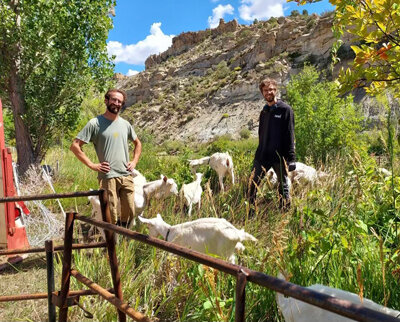
Jonathan Bartley and Adrian Lacasse of DuranGoats, who use goats to clear undergrowth around private houses to lessen fire danger.
By Dave Marston | PREVIEW Columnist
Goats are particularly good at one thing: Eating. Unlike a horse or cow that leaves noxious weeds behind, goats eat the whole menu of pesky weeds, bushes and small trees. That means goats can be one of the answers to the growing problem of tinder-dry, highly flammable forests.
In Durango, Colo., former firefighter Jonathan Bartley runs a business called DuranGoats, along with partner Adrian Lacasse, and it’s so popular they’re booked daily. Their herd usually works along the wildland-urban interface of the San Juan National Forest, clearing undergrowth around private houses in heavily wooded, steep areas at the town’s periphery.
Thanks to his work, Bartley has come to a conclusion about newcomers to the West: “When people move here thinking ‘I’d love to live in the woods,’ they’re probably making a big mistake.”
If they do choose to live surrounded by trees or next to a forest, though, he has advice.
Because utilities cut off electricity during fires, he suggests buying a generator to keep sprinklers for irrigation running. He also advises homeowners to install a metal roof to repel wind-driven sparks.
Always, he adds, have a go-bag ready with your most important stuff if flight becomes necessary. Most of all, he wants homeowners to create flame breaks around their house with gravel while also cutting back trees and shrubs within 30 feet of the house.
That last bit of advice is key. Firefighters triage neighborhoods, he said, picking winners and losers. When they scan neighborhoods quickly, they tend to give defensible homes extra resources while deciding that the brushy, overgrown properties are going to be lost causes.
Bartley knows fire well. He worked for a private company as part of a hand crew of 20 based in Eugene, Ore. There, the Holiday Farm Fire started within a half mile of his house. From that experience, he learned that our approach to wildfire is backward: “We react, rather than manage landscapes ahead of time. Spending a few million dollars on fire mitigation would have saved hundreds of millions of dollars.”
These days, he said, “I’m still fighting fires — just with goats.”
Bartley is quick to point out that fire itself is beneficial to forests. Even Cal-Fire, the firefighting arm of the state of California, says on its website, “Fire removes low-growing underbrush, cleans the forest floor of debris, opens it up to sunlight and nourishes the soil.”
The problem across the West, Bartley said, is so many unmanaged dense forests full of deadfall and brush — “ladder fuels” — that allow fire to climb into tree canopies. “By the time wildfire gets into the treetops to become crown fires,” Bartley said, “firefighters have evacuated and are miles away.”
Everyone knows that western wildfires are becoming worse. Half of the 10 biggest fires in the United States this century all burned in this region. When wildfires grow massive and super hot, they destroy forest ecosystems, leaving nearly sterilized bare ground that’s perfect for flammable cheatgrass to invade. That sets up burned areas to burn again, often quickly.
Bartley has big ambitions for his goat herd, which can clear a quarter acre in a day. DuranGoats charges $400 daily, he said, much less than the cost of a crew of landscapers armed with weed whackers and loppers on hilly, broken terrain. Moreover, the goats’ sharp hooves churn the dirt and fertilize it with poop and pee, setting up a regenerative cycle that improves the soil.
In northwestern Montana, former journalist David Reese has a similar business.
His herd moves daily, and once the animals strip leaves off small trees and gobble up the cheatgrass and knapweed, he said, it’s quick work to chain saw small trees and dead branches.
Like Bartley, Reese has found he has almost more business than he can handle. He plans to scale his herd to 400 goats, while Bartley aims to build up to 100 goats. Both are angling for bigger contracts from homeowners and also government agencies.
Finding four-legged workers is easy. “A male dairy goat has a life expectancy of a week,” said Bartley. “They’re not plump like meat goats, have no dairy value and often are dispatched at birth.”
Extra income for DuranGoats comes from outdoor weddings. Festooned with wildflowers and bells, goats roam the grounds and are a favorite with all the guests, even pitching in as ring-bearers or, in a pinch, groomsmen. But like any single man at a wedding, they have a wandering eye, which means that flower arrangements can be gobbled up quickly.
Dave Marston is the publisher of Writers on the Range, writersontherange.org, an independent nonprofit dedicated to spurring lively conversation about the West. He lives in Durango, Colo. Views expressed do not necessarily represent those of The SUN.